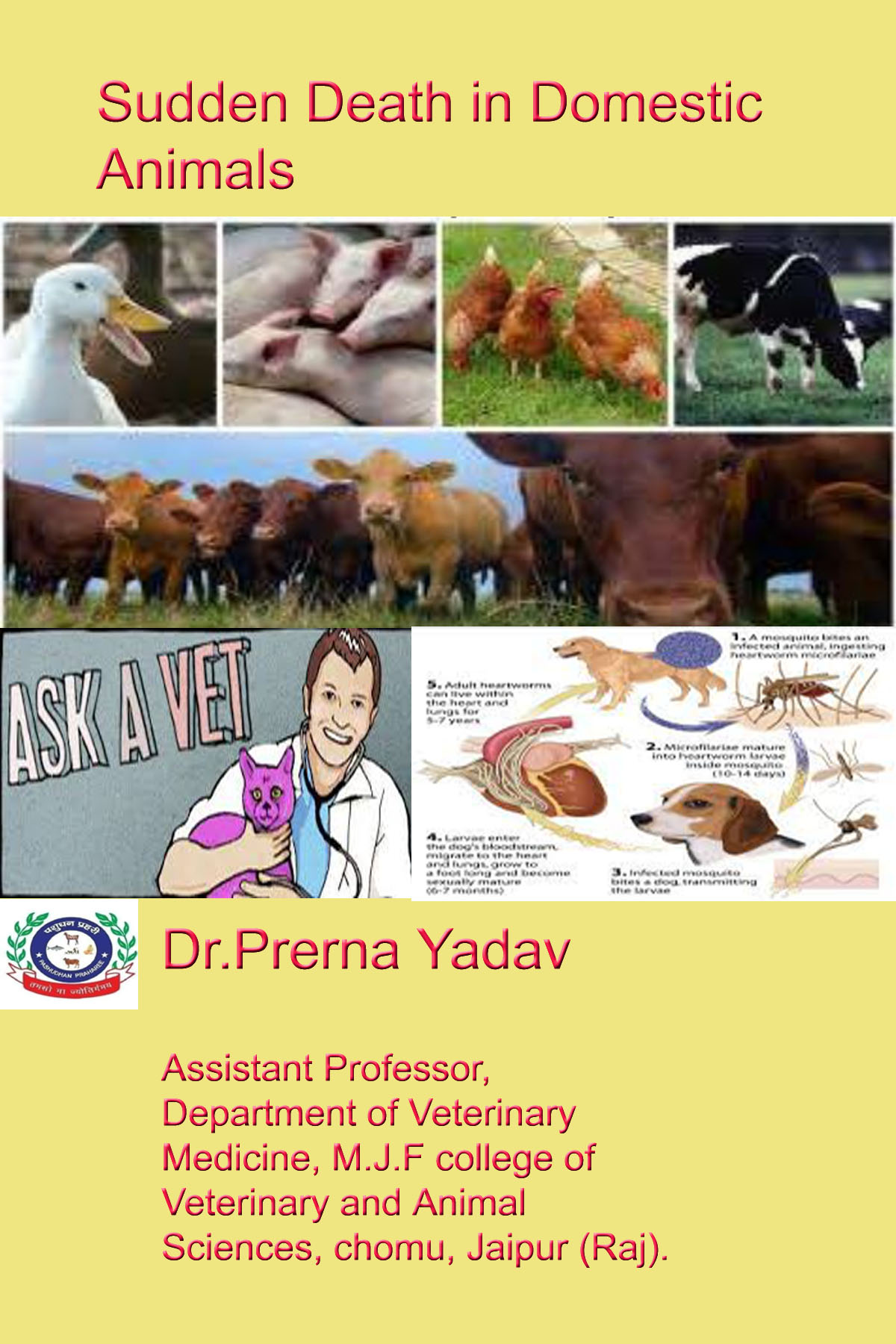Sudden Death in Domestic Animals
Prerna Yadav
Assistant Professor, Department of Veterinary Medicine, M.J.F college of Veterinary and Animal Sciences, chomu, Jaipur (Raj).
Introduction
Unexplained death occurring in apparently healthy animals within 12 to 24 hours with no previous clinical illness or symptoms. Mostly occurs in cattle but also affects other species like sheep, goat, horses, and pigs. For such cases, owners usually report that the animal was normally eating and in healthy condition but the next day found dead.
Causes
Common causes of sudden death are infectious causes, spontaneous hemorrhage, metabolic disorders, poisoning, other causes, and animal abuse. The various causes of sudden death in cattle are Infectious (such as bacterial pneumonia, anthrax, clostridium diseases – blackleg, botulism, red water disease, and anaplasmosis; Animal abuses (such as poisoning and trauma); Spontaneous hemorrhage due to rupture of a uterine artery or pulmonary trunk and aorta; Poisoning (such as lead, organophosphate, copper, cyanide, nitrate, gossypol, plants – Hemlock, Datura and Nerium spps); other causes (such as lightning stroke, bloat, accidental injury, neonatal septicemia). In case of horse’s causes are trauma (skull), twists/torsions/ruptures, clostridial diseases (such as tyzzers disease, botulism, blackleg), salmonellosis, white muscle disease, colic, i/v injection of potassium or insulin, cardiac arrhythmia, internal hemorrhage, aortic ring hemorrhage, guttural pouch hemorrhage, organophosphates poisoning, and neonatal diseases. Causes of sudden death in pigs are electrocution, Hemophilus pneumonia. salmonellosis, stroke, salt poisoning/dehydration, post-partum uterine rupture, porcine stress syndrome, and neonatal diseases. Sheep/goats were also encountered with sudden death due to acute pneumonia, coccidiosis, misadventures post-partum septicemia, clostridium diseases (such as blackleg, enterotoxaemia, and lamb dysentery), poisoning (such as Ionophores, copper and oxalate plants), and neonatal diseases such as hypothermia. Some plants producing sudden death in domestic animals are Nerium spps., Hemlock plant, Datura, green Cestrum, Bryophyllum (mother of millions) and sorghum, etc. The chemical or toxin present in these plants (Nerium-cardiac glycoside, Hemlock-nicotine, Datura-scopolamine and atropine, Cestrum-carboxyparquin and Chokeberry-glycoside amygdalin) produces death within 24 hours. Sometimes sudden death may be acquired in animals after grazing on pastures such as lush pasture grazing in spring and winter season, mainly on foothills is responsible for grass tetany and foggage pasture grazing produces fog fever.
Field investigation
Approach towards investigation for such cases includes proper history taking, a thorough examination of carcass externally including environment, detailed post mortem examination, use of rapid field test and kits and sampling for confirmative diagnosis and transport them to the laboratory in a prescribed manner so that effective control measures could be adopted to further reduce spread and mortality. History should be recorded for age, breed, sex, number of deaths, number in affected group, the interval between last inspection and animal being found dead, history of clinical signs in the dead animal or others in the group, body condition of the dead animal compared to the rest of the group, stall feeding or at pasture, grazing/feeding history including recent changes in diet, recent weather events (flooding storms, lightning, etc)., vaccination and deworming history, previous treatment history, recent handling (dipping, transport, weaning, mixing of groups, new arrival of animal), location of the carcass and legal and insurance cases. An external examination should be performed to access body condition, mucous membranes: check for anemia, jaundice, hemorrhages, ulceration and vesicles, any discharges from eyes, nose, vulva, and anu and evidence of trauma and fracture. Veterinarians should be familiarized with common post mortem lession of infectious disease (such as pneumonia, lamb dysentery, pulpy kidney disease, etc.), spontaneous hemorrhage, managemental and metabolic diseases (such as pregnancy toxaemia, feedlot, fatty liver disease, and many more), poisoning in animals (copper, lead, cyanide, and nitrate, etc.) other causes of sudden death such as bloat and lightning stroke). Rapid field test kit for the chemical test such as diphenyllamine blue test for nitrate poisoning and picrate paper test- for HCN poisoning. Samples to be collected for confirmative diagnosis (liver – 500-1000g, stomach contents- 500-1000g, brain – entire, kidney- one, urine-50ml, blood- 30-50 ml, feed, water, plants- 1kg). Individual containers should be labeled with the date, location, and identity before sending to the laboratory.
Conclusion
The context of sudden death in the present scenario is very important because it reduces undue pressure on veterinarians as they could give immediate diagnosis, it also serves its role in vetero-legal purpose, legal/insurance aspect and to prevent the risk of death in remaining stock.



